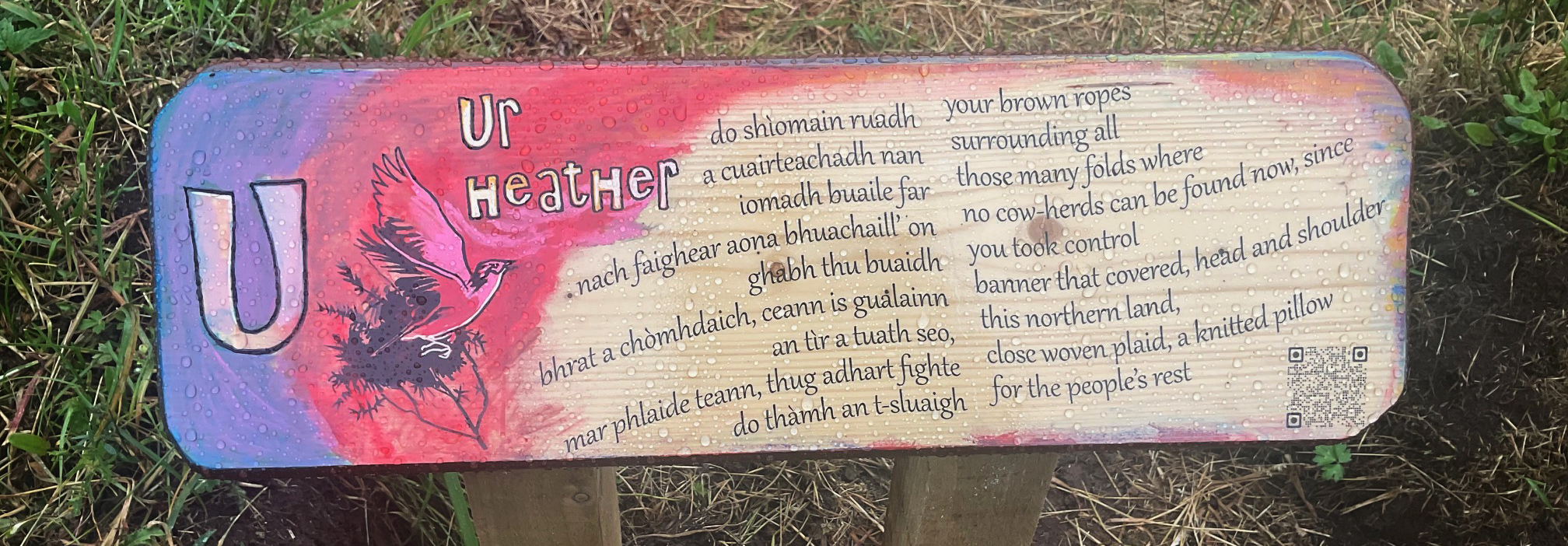
B L N F S H D T C M G P R A O U E I


do shìomain ruadh
a cuairteachadh nan
iomadh buaile far
nach faighear
aona bhuachaill' on
ghabh thu buaidh
bhrat a chòmhdaich
ceann is gualainn
an tìr a tuath seo,
mar phlaide teann,
thug adhart fighte
do thàmh an t-sluaigh
leann na slàinte
bho'n t-saoghal àrsaidh,
brìgh na meala
dh'an t-seilean dligheach,
buigead bobhstair
do chuspair ruaig
sguab is pasgart
is tughadh daingeann,
do thìr 's do mhuinntir,
ri am an fhòirneirt
na d' bhraidseal clisgidh,
na d'fhalaisg dùsgaidh
your brown ropes
surrounding all
those many folds where
no cow-herds can be
found now, since
you took control
banner that covered,
head and shoulder,
this northern land,
close woven plaid,
a knitted pillow
for the people's rest
an ale for health
from the ancient world,
source of honey
to the dutiful bee,
softest mattress
for fugitives
broom and basket
and close-bond thatch
for land and folk,
in time of onset
a fire to startle,
heathfire to stir life
Heather commonly grows in northern and western Europe, Turkey, Morocco, and has been naturalized to parts of North America. It is especially relevant to Scotland, where its name is believed to come from the Scottish word haeddre, which was used to describe a heathland, or shrubland.
Ling heathers (calluna vulgaris) do best in full sun with acidic, well-draining soil and the flower’s meaning comes from its genus name, Calluna, which stems from the Greek word kalluno, and means to cleanse or adorn.
"When the north of Europe was a forest, open land was naturally preferred for the site of dwellings; the heath was the only open land, and thus acquired a name that has been used to designate a field or homestead" (from Alexander Wallace book, Heather in Lore). However, just as willow has connection to the word witch, heather or heath also sources to the word heathen, in which ‘heathen’ gives different resonance to its meaning.


Heather was used in thatching, broom-making, rope-twisting, basket-weaving, stuffing mattresses and making dyes. Heather honey was produced by bee keepers, particularly te British Black Bee.
Heather flowers and leaves were used in medicine to treat coughs and asthma and as an ointment for arthritis and rheumatism. There are records dating back to the seventh century of heather’s healing properties..



The Celts often referred to heather as a plant of attraction, romance and intoxication. Ale and mead were made using heather, explaining the intoxication and heather ale is still common.
In the sixteenth century, German doctor Paulus Aegineta noted that the flowers, leaves, and stems healed various types of sores, both internal and external. Nicolas Alexandre, a Benedictine monk, also noted that heather tea could dissolve kidney stones. Today, heather is still used by some to aid in urinary tract and digestive conditions, among other things




A word largely used by early Christians referring to those who dwelled upon the heath and followed the old ways, it later mutated into a word for an uncivilised, godless savage.
Despite this there are some delightful superstitions that still surround heather. The tree of the summer solstice, it is said that heather lights the flames of fairy passions, opening the door between this world and the Otherworld. So, if you wish to attract the fairies, make an offering of heather during Beltane!


Heather is also associated with spiritual healing and development and worn as a charm to protect against violent crime. In the sixteenth century, Clan Ranald believed that they won a battle because they wore white heather in their bonnets, which gave them both luck and protection.
White heather, unselfish love and unlucky to bring indoors have connection in a sad tale that involves a princess called Malvina who fell deeply in love with a warrior named Oscar. On the eve of their wedding, Oscar was cruelly slaughtered in battle and on receipt of this tragic news Malvina wept in despair, holding in her hands the last piece of heather her true love had ever picked for her. So powerful was her grief that her tears turned the heather to white. Desiring for nobody to experience the pain she felt, Malvina made a wish that white heather should hereafter bring good fortune to all who find it.
In Scotland, it is common to include a sprig of white heather in a bride’s bouquet for good luck and at Beltane branches were carried around the fire three times before being raised above dwellings to protect from evil eye. Throwing heather after someone supposed to bring them luck. The skylark (laverock in Scots), is the great singer, high up above its heathland home
